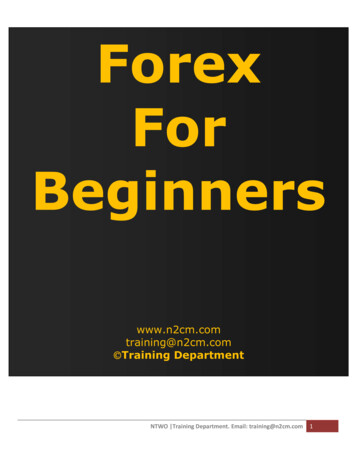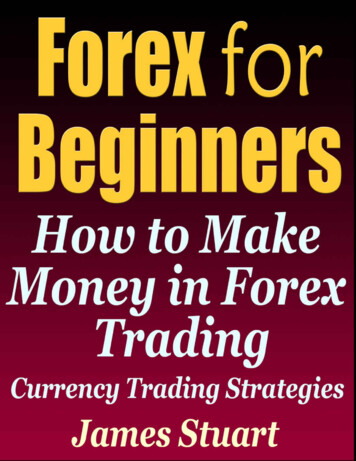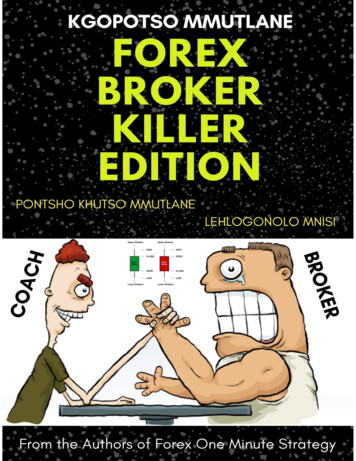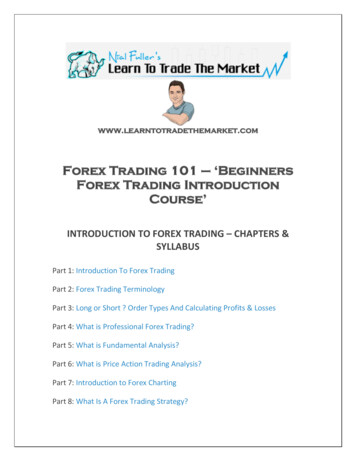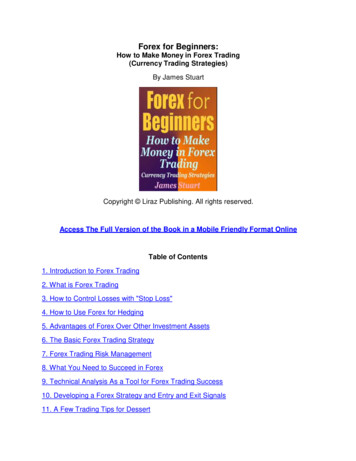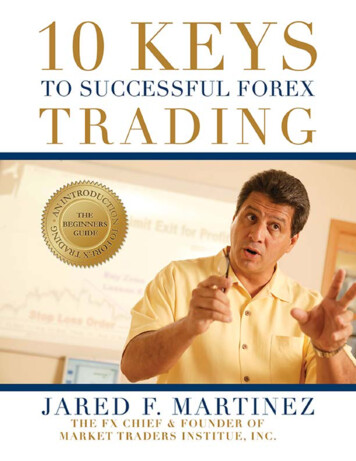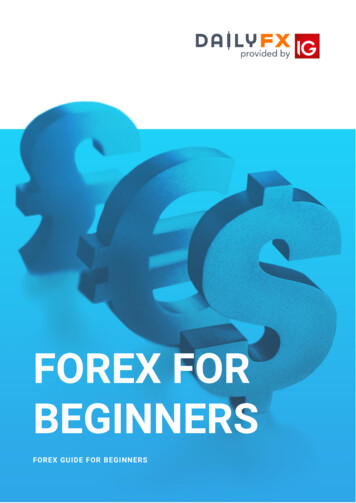
Transcription
FOREX FORBEGINNERSFOREX GUIDE FOR BEGI NNERS
FOREX FOR BEGINNERSDailyFX Research TeamTable of ContentsWhat is Forex? . 3What is FX 2 - How to Trade FX . 4Why Do So Many Traders Move to or Focus on Forex? . 6Trading FX – What Drives the Forex Market? . 7The Bulls and the Bears – Deciding What to Buy and Sell . 8Reading a Quote . 9One of the most important terms that’s unique to FX: Pip . 9Two-Sided Pairs, Two-Sided Trades . 10Going Short . 11Pip Values . 12Lot sizing. 12Margin . 13Leverage . 14Anatomy of a Forex Trade – Start to Finish . 14Next Steps . 15Disclaimer.162
FOREX FOR BEGINNERSDailyFX Research TeamWhat is Forex?Forex is short for Foreign-Exchange, and it is the largest market on the Planet Earth. Whilemany investors, particularly many in Western economies may be more-aware of equity and stockmarkets, Forex plays a key role in the constantly evolving relationship of global trade.Even if you don’t know it – you’ve probably already placed a Forex trade. Have you ever withdrawnmoney from an ATM in a foreign country in a foreign currency? Well – that was a Forex trade. If you’veflown into an international airport and seen the airport kiosks with flashing rates, those are all bidsand offers to place an FX trade. Even if you haven’t travelled out of country, you’ve likely purchased agood or service online from a merchant in another country. Well, there’s a Forex transaction behindthat sale.Forex is like oil for the gears of global trade. And as globalization has further taken-hold of the world,the necessity for FX to facilitate those trading relationships has never been more important. If aJapanese automobile manufacturer wants to sell a car in the United States – the USD/JPY exchangerate is going to be pretty important to the success of their business. If the Dollar strengthens, this isgood for the Japanese auto manufacturer – as they can now bring back more Yen for every car soldin the United States, given the stronger U.S. Dollar. But if the exchange rate weakens – this automanufacturer may be forced to take a loss on the sale of that car, and for no fault of their own, asthey were simply the victim of a ‘bad forex trade’.But no dialed-in, international company is going to remain vulnerable to such unchecked marketforces. Ignoring exchange rates could risk the very success of their business to a factor that theycould reasonable control for. So many companies are actively trading in FX markets in order toaddress the risk of constantly changing valuations in their local currency.But this is just one motivation for one particularly important participant in the market. In manycases, the auto manufacturer themselves are going to outsource this work to one of the majorbanks with a heavy focus on Foreign Exchange transactions. And given the volatility that can oftenemanate from these markets, this will also attract many hedge funds or pension funds with someelement of a speculative bent.Collectively, this activity from these ‘major’ market participants is what makes FX the largest marketin the world.3
FOREX FOR BEGINNERSDailyFX Research TeamWhat is FX 2 - How to Trade FXAs we mentioned earlier, many people place Forex trades every single day without ever knowing it.But for those that do knowingly trade FX – the purpose is fairly clear: for profit – just as with any othermarket-based type of investment.Let’s go back to that airport kiosk example: And let’s say that you’ve just arrived in New York after ared-eye flight from London, and you know that you’re going to need to exchange some of your BritishPounds into U.S. Dollars in order to have some pocket cash for transactions. But you’re unsure of howmuch you’ll need, so you simply take everything out of your wallet and exchange it into U.S. Dollars;and that just happens to be 400.00.Bid1.2400(price at which you can sell)Ask1.2500(price at which you can buy)At the time of the exchange, the airport kiosk was displaying a rate of 1.2400 x 1.2500 for transactionsfrom the British Pound to the U.S. Dollar. This would be very similar to a Forex quote with a relevantbid and ask, separated by the ‘spread’ between the two prices. The first price is the amount that theairport kiosk would be willing to buy GBP/USD from you while the higher, or second price is the rateat which they’d be willing to sell. So, you, as the customer, buy at the higher price and sell at the lowerprice the airport kiosk always earns the spread.Another way to read this quote from the airport kiosk would be: ‘we are willing to pay 1.2400 in U.S.Dollars for every 1 British Pound you have – but if you want to buy British pounds from us, it’s goingto be at a rate of 1.2500 for every 1 GBP that you want.’ The difference between these two amountsis the ‘spread,’ and this is vitally important for traders to follow – but we’ll get to that in a moment.You exchange your 400.00 for 496.00 (400 x 1.24) and then leave the airport to go and enjoy thebeautiful weather in New York City.But while enjoying all of that beautiful weather, you realize that much of NYC is wired to acceptcredit cards. So you don’t really need any of your cash, and the 496.00 remains unfettered in yourwallet for the duration of your trip. Now it’s time to go back home, and you decide you want to getyour GBP back so that you can actually use your cash at home. You go to the same airport kiosk –but now prices have changed as the British Pound has dropped in value since when you’d arrived inNew York.4
FOREX FOR BEGINNERSDailyFX Research TeamGBP/USD RateBid1.2200(price at which you can sell)Ask1.2300(price at which you can buy)Now the airport kiosk reads 1.2200 x 1.2300 for GBP/USD exchanges. And you take out your 496,and hand it to the agent at the kiosk, and they give you back 403.25 – amounting to a net profit ofalmost 3.25 on the transaction – and all you had to do was hold that cash in your wallet for a week.Curiously, you pose a befuddled look to the attendant at the airport kiosk currency exchange andexplain that they must’ve made a mistake as you’d only given them 400 and are now getting back afull 3.25 extra – almost a 1% return in just a single week!You ask the attendant at the kiosk to explain the transaction; and they share that during this weekthat you were in New York, the British Pound dropped in value by 200 pips (equivalent to 2 cents)against the U.S. Dollar. This means that by having ‘invested’ in the U.S. Dollar rather than the BritishPound, you were able to profit off of the drop in the exchange rate. So, when you traded in yourBritish Pounds, you did so at a rate when every British Pound was worth 1.2500. But now that theBritish Pound has fallen in value with each British Pound now returning 1.2300, you profited off ofthe transaction. And when the attendant takes your 496 to exchange it back into British Pounds,the lower rate of 1.2300 means that you’re going to get back 403.25 (496 X (1/1.2300)).At that point, you get the idea that speculating on currencies can be a viable ‘endeavor’ as the dailymovements in a currency’s value or price can allow for profit to be had from astute observation andtiming.This is the enterprise that many of the world’s largest investors – whether they’re banks or insurancecompanies or auto manufacturers or stay-at-home Mom’s or Dad’s managing a personal tradingaccount – are all trying to do. The bulk of the 5 trillion per day exchanged in the FX market comeswith a profit-seeking, loss-aversion backdrop.5
FOREX FOR BEGINNERSDailyFX Research TeamWhy Do So Many Traders Move to or Focus on Forex?As with equities, the proliferation of computers and subsequently the creation of the internetpopularized the field of Foreign-Exchange trading. Some of the unique aspects of the FX market areparticularly attractive to market participants, such as:- FX Never Sleeps, this is a 24-hour market because when London closes for business, banks in theUnited States are furnishing prices. And as the U.S. closes for the day, liquidity begins to flow fromNew Zealand, Australia and then, eventually, Asia; producing a truly ‘always open’ market for FXtraders.- Go long or short – there are no shares to borrow and no ‘hypothecation’ that needs to take placewhen going ‘short’ on a Forex-pair. The two-sided pairing of many FX instruments also affords anextra level of flexibility. Do you want to short the British Pound? Well, you can choose to do thatagainst the U.S. Dollar or the Japanese Yen or the Euro. You get have many options to choose from.– this is particularly attractive to professional-level investors as the inevitable costs of placing tradescan place a large dent into a trader’s profits. Trades are some of the lowest-cost vehicles thatinvestors can work with given the massive liquidity and substantial size and depth that often existsin these markets.- Un-paralleled liquidity – as mentioned earlier, over 5 Trillion per day turns over in the Forex marketand this means that most major FX markets remain widely-offered throughout the day. A lack ofliquidity can be a dangerous prospect for a trader as this can increase the ‘sharpness’ of moves giventhe thinned number of bids or offers in a market. Such ‘violent’ price movements can just as surelywork against a trader as for them. The additional liquidity that’s often available in FX therefore canact as a ‘buffer’ for price action.- Available leverage: borrowed funds can fast become a detriment if miss-used, and we’ll talk aboutthis in more detail later. Leverage gives the trader flexibility for bolstering amplitude. If a trader wantsto speculate on a move more aggressively, they can institute more leverage. But this can bedangerous as higher degrees of leverage accelerates the ‘velocity’ of a trade.6
FOREX FOR BEGINNERSDailyFX Research TeamIn FX – you get to control your own leverage up to 50x in most jurisdictions. And while mostprofessional traders would agree that 50x leverage is too aggressive for a professional approach –in FX, you get to decide.Trading FX – What Drives the Forex Market?Currencies trade on the open market, just like many other asset classes like stocks or bonds orcommodities. Throughout the trading day, prices on currencies will fluctuate based on supply anddemand. If something ‘good’ happens for an economy, investors will generally respond with morebuying. That in turns increases demand at given levels of supply, thereby increasing prices until supplyand demand are roughly-balanced again. Or, if something ‘bad ‘happens, investors will factor that newinformation in by selling the currency, which increases supply at this given price. An increase in supplywould bring prices lower until buyers stepped-in to add support and, again, we’d have equilibrium inthe supply and demand for that currency at that moment in time at that specific price.Let’s take the Brexit vote in June 2016 as an example. When voters in the U.K. elected to leave theEuropean Union, the immediate response was one of fear as investors sold-out of GBP-basedinvestments. All of those orders to sell (supply) rapidly filtered into price as the quote on GBP/USDfell by more than 15 cents (1,500 pips) against the U.S. Dollar in a single night, from 1.50 all the waydown to 1.3500.The general motivator for currency price movements are interest rates, or implications thereof As an economy’s performance improves, interest rates will generally be increased to temperinflationary pressures. But it’s those increasing rates that really get currency traders excited, as thiscould bring on a synergistic relationship that can, potentially, last for months or even years. As interestrates move-higher, the demand to invest in that economy will generally increase in order to capturethe consequently higher rates of return. As this demand builds, so does demand for the nativecurrency, fueling an advance in exchange rates to match local capital markets.Investors can even earn (or pay) interest while being in a forex trade, reflected in the ‘swap rate’. Thisis the interest rate differential between representative economies in a Forex quote, and we explainthis later in more detail.7
FOREX FOR BEGINNERSDailyFX Research TeamThe Bulls and the Bears – Deciding What to Buy and SellAs mentioned above, interest rates are one of the most common drivers for currency prices, but toput it more accurately, it is ‘expectations for potential changes in interest rates’ that really drivesmatters. Let’s consider an example: if data signaled a remarkably strong development for an economy– let’s say that GDP in the U.K. far outpaced what was expected – the speculation will in turn weighin.While this one, individual GDP print may not cause the Bank of England to hike interest rates, it canstart the ball rolling. The stronger economic figure may in turn raise the prospect of inflation. It is thatelevated price pressure that may eventually cause the BoE to hike rates faster than they would haveotherwise. So this would generate an increase in expectations for higher interest rates which in turnmotivate traders and investors to buy the British Pound (and local assets) on the belief that the rateof return is going to rise in the near future.The higher prices in the British Pound, at this point, would be ‘Bullish’, reflecting the burgeoning uptrend that’s taking place to account for stronger GDP and rate expectations. Should data continue tocome-in stronger, this ‘bullish’ price action can continue. If persistent enough, the result could be atrue ‘bullish’ up-trend in the price/value of the currency.If the example were to be reversed – with the expectation for lower interest rates – the result is morelikely to drive currency values lower. Such expectations were evidenced after the June 2016 Brexitreferendum. After the vote deciding to withdrawal the UK from the European Union, Bank of EnglandGovernor Mark Carney warned markets that the BoE was not going to take risks from the referendumlightly. They would proactively look to offset those risks by decreasing interest rates. In short order,sellers returned to drive the value in the British Pound even-lower, from a value of 1.3500 just beforethe ‘warning’ to around 1.2000 in the months after. This is clear bearish anticipatory price action.This is the simplified interpretation of the relationship that drives most buying and selling decisionsin the FX market. Do you think that economic prospects in Europe will improve? If so, you could buythe Euro. And as those prospects do indeed improve, prices will likely move up to reflect the increaseddemand preempting inflationary pressure that could prompt higher rates. Or, if you think that Europe’seconomic prospects are worsening, you can sell the Euro to take advantage of an eventual slide inrates that promotes a decline in the market.8
FOREX FOR BEGINNERSDailyFX Research TeamReading a QuoteThe quote convention for the Forex market is one of the few areas that’s markedly different than manyother markets, but after a little investigation it often becomes quite simple for most investors.FX trades take the prospect of detail a step further . But before we get to that we have to point outan important element of terminology in the FX market, and that’s the term ‘pip’.One of the most important terms that’s unique to FX: PipPip stands for ‘percentage in point,’ and this is the primary unit of measurement in a forex quote. In aU.S. Dollar denominated-quote in which USD is the ‘quote currency’ (any pairing where ‘USD’ is listedsecond), the third and fourth digit after the decimal will show the number of ‘pips’ in that quote.If GBP/USD is trading at 1.2345, this is the same as saying ‘one British pound is worth one dollar, 23cents, and 45/100th’s of a cent’. If the price in GBP/USD increases to 1.2355, that would be a gain of10 pips (1/10th of a cent). If price were to rise to 1.2445, that would be a 100-pip (one cent) gain fromthe prior value of 1.2345.GBP/USD‘The Value of One British Pound, quoted in terms of U.S. Dollars’GBP is the base, or transaction currency in the pairUSD is the quote, or counter currency in the pairThe price of GBP/USD moving higher means British Pounds are Stronger, and U.S. Dollars weakerThe price of GBP/USD moving down means British Pounds are weaker, and U.S. Dollars strongerEvery Forex quote comes as a pair so that we can see what that base currency’s price is being definedagainst. GBP/USD is one of the more common pairings, and its pairing is the same as saying ‘thevalue of British Pounds, quoted in U.S. Dollars’. EUR/GBP is another common pairing, and this is thevalue of one Euro, as quoted in British Pounds. Or let’s say we wanted to place a trade with anAustralian focus: We could look at GBP/AUD, which is the value of one Pound quoted in AustralianDollars.9
FOREX FOR BEGINNERSDailyFX Research TeamTwo-Sided Pairs, Two-Sided TradesSo, to recap: the first currency in the pair is called the ‘base’ currency, and this is the instrument beingquoted in that price; while the second currency in the pair is the ‘counter’ currency, and this is whatthe base currency is being quoted in. So, for example, the quote for GBP/JPY would be the value ofone British Pound as quoted in Japanese Yen, reflected as 140.00 to show that each British Poundwas worth 140 Yen ( ).While an exchange rises and falls simply enough, the values of both currencies do changeindependently. Euros are going up and down throughout the day, as are U.S. Dollars and JapaneseYen – and traders should seek pairings that would offer the best leverage to support their view fordirection. So, if the investor wanted to buy British Pounds as they are bullish on the currency’s outlook,they would want to pair that currency against a counterpart that they expect to be weak.As an example, if an investor expected the Australian economy to be weaker – they could buyGBP/AUD; or buy British Pounds against Australian Dollars.Or – alternatively – if the investor was ‘bearish’ on Europe’s economic prospects, they could sell Eurosand buy British Pounds. This would be employed by ‘going short’ EUR/GBP, which is the equivalent ofselling Euros in terms of British Pounds.In this last example, the investor hopes that the EUR/GBP exchange rate (its price) goes lower, atwhich point they could ‘cover’ the trade at the lower price, allowing for profit in the short positiontaking the difference between the higher entry price and the lower exit price.10
FOREX FOR BEGINNERSDailyFX Research TeamGoing ShortEntering a short position in the stock market can be challenging. Before you can place the trade, youfirst need to find a broker that will let you borrow the shares in the first place. Following that, executingthe short position is usually going to come with some restrictions, such as the ‘uptick rule’. And evenshould you meet all these criteria, you’re often going to have to pay interest for ‘borrowing’ the sharesat ‘brokers call’ rates, which are usually higher than discount or prime rates.Suffice it to say, betting against stocks usually isn’t as easy as buying them.Forex is quite a bit different because in every quote, in each trade, investors are always ‘long’ onecurrency and ‘short’ another. Let’s go back to that GBP/AUD example:If investors were optimistic on British economic prospects, at least more so than they are onAustralian growth prospects, they can look to buy GBP/AUD. But if investors are more-pessimistic onthe U.K.’s economic prospects as opposed to Australia’s, a short position could be executed in whichthe investor sells GBP/AUD. Let’s say this happens at a price of 1.7000, and you go short for 10 lotsor 100k.In this hypothetical short GBP/AUD position, the investor would be short British Pounds, and longAustralian Dollars. Each pip in the quote would be worth approximately 58.8 pence (1/1.7000 0.5882). And, considering the investor has 10 lots, each pip gained or lost would mean approximately 5.88 of change to the investors account.Let’s say two months later, the investor closes out the trade at a lower level of 1.6000. This would bea total movement of 1,000 pips, and the investor can close the position at the lower price to garnerthe equivalent gain. Further, given of the pip value of 58.8 pence per pip, each lot would’ve brought 588.24 to the investor. On a 10 lot position, that would tally a total gain of 5,882.35 on the ‘short’trade.11
FOREX FOR BEGINNERSDailyFX Research TeamPip ValuesThis is an extremely important aspect of the Forex market to understand, and that’s the value of a pipfrom quote to quote. Every currency pair is priced in terms of the counter currency. So if ‘USD’ is thesecond currency in the quote, that currency pair is being quoted in terms of U.S. Dollars. As anotherexample, if the Australian Dollar is listed second, as we saw above with GBP/AUD, the trade is beingpriced in-terms of Australian Dollars.Again, if you are ever confused, just read the quote aloud as ‘the value of (first currency) priced interms of (second currency)’.For U.K. traders using a GBP-based account, the pip value for each pip in GBP/USD can be found bydividing ‘1’ by the quote itself. So if GBP/USD is trading at 1.2500, the pip value for GBP-based traderswould be ‘1/1.2500 0 8’. So, each pip of movement in GBP/USD would be worth 80 pence, or 0.8GBP.If we wanted to find the value of each pip in the GBP/AUD quote, we can follow the same procedure.We can divide ‘1/GBPAUD quote’. Let’s assume a value of 1.7000 for GBP/AUD, at which point, thepip value would be ‘1/1.7000 0.588’. So, each pip of movement in GBP/AUD would be worth 58.8pence, or 0.588 GBP.Lot sizingAs you can probably imagine, traders don’t usually get excited by a gain of a few cents or pence. But,with leverage and lot sizing – that movement of only a few cents can really stack up to bring somesignificant gain (or damage) to a trader’s account.Each currency pair is denominated in a ‘base lot size’ that carries a ‘pip value’ for each pip’s worth ofmovement in that specific currency pair, just as we saw above with GBP/AUD carrying a pip value of0.588 for GBP-based traders. Each lot also carries a ‘minimum margin requirement’, and this is theamount of risk capital required to maintain the position.12
FOREX FOR BEGINNERSDailyFX Research TeamMarginMargin is the capital that the broker must hold in order to secure a position. This amount will differfrom currency pair to currency pair, but will generally be a percentage of the overall size of the trade.Let’s assume a margin factor of 2% for positions.Let’s also assume that the trader wanted to buy 50,000 in GBP/USD. This would be referred to as the‘lot size’ of the trade.And then let’s assume a cross rate of 1.2400 in GBP/USD at the time.As we mentioned earlier, this quote is pricing GBP in terms of the U.S. Dollar. And if the going rate ata given time is 1.2400, that’s saying that each British Pound is worth One Dollar and 24 cents. So thistrade to transact 50,000 would be worth 62,000 (50,000 X 1.24 62,000). This is called the notionalvalue of the trade.The minimum margin requirement for this trade, if using 2% as a margin factor, would be 1,240( 62,000 x .02).We can also express this amount in GBP equivalent by using the exchange rate of 1.2400 in GBP/USD. 1,240 would be worth 1,000 (or 2% of 50,000).When our trader places the trade, this amount will be drawn from the account and earmarked for thisposition as ‘margin’. Once the trade is closed, this margin comes back to the trader’s account andcan be used again. But, if in the course of trading, the position loses value to deplete the trader’sequity – to where he or she only has the margin securing the trade remaining – this trader will face a‘margin call’ as there would not be enough capital in the account to continue supporting the position.Margin Call – When the trader’s account value falls below the margin requirement of held positions.This leads to a liquidation of the account from the broker; known as the dreaded ‘Margin Call’.13
FOREX FOR BEGINNERSDailyFX Research TeamLeverageLeverage is the amount of funds borrowed from or used from the broker. Let’s assume that our traderin the above position had opened their account with 2,000, and is currently trading a 50,000position.The leverage on this trade can be expressed as 25:1. Or, to put it otherwise, the trader is controlling 25 of capital for every 1 in their account.Remember, margin had to be put up in order to secure the position before it was ever executed, andthat amount was 1,240 (or 1,000). This means that our trader would have 1,000 in ‘free margin’,or capital that isn’t currently tied-up in securing a position. This is capital that can be used to pursuenew positions or to support currently-held trades.Anatomy of a Forex Trade – Start to FinishTo close our New to Forex Guide, we’re going to walk through a complete hypothetical trade, fromstart to finish using EUR/USD.Let’s assume a bid/ask rate of 1.1000 x 1.1005, a margin factor of 2%, and a newly opened accountwith 2,000.Our trader decides that they want to place a short EUR/USD trade for 20,000.Because the quote is Euro’s priced in terms of U.S. Dollars, 20,000 would be the same as 22,000.We are using the bid price – first in the quote – since our trader is opening a short position). The 22,000 would be the notional size of the lot.The margin to open the position would be 440 ( 22,000 x 0.02). This would leave our trader with 1,560 in free or ‘available’ margin.The pip value on the position would be 2.00 per pip, since this is a U.S. Dollar denominated accountand we’re trading a pair based in U.S. Dollars. So, the 1,560 that the trader has in free margin wouldallow for 780 pips to be lost before a margin call would happen ( 1,560/2 780).But let’s assume that the hypothetical trade found its way into the money. With a slide, the price onEUR/USD went down to 1.0805 x 1.0810, and the trader decided they wanted to close the lot.14
FOREX FOR BEGINNERSDailyFX Research TeamThey’d have to buy back to cover the position, which would be done at the second rate in the quote,or the ‘ask price’.Our trader would be covering 20,000 at a rate of 1.0810, for total proceeds of 21,620; amounting toa net gain of 190 pips.The original cost of the trade was 22,000; but now the trader covers the position at a value of 21,620– leading to a 380 difference which would be realized as profit on the trader’s short position.Once the trade is closed, the margin is returned to the account and the trader’s net account value isnow 2,380.Next StepsBy now, you have learned many of the basics that helps a trader familiarize to navigating any market,Forex included. Many professional traders consider markets a life-long learning process, very similarto driving. At first, even driving at low speeds on abandoned roads can be risky and scary. But in time,as the mechanics of operating an automobile become a little more comfortable, we can fly bymotorists on the highway without so much as a worry in the world. Experience helps bring familiarityand comfort.At DailyFX, we’re here to share our experience with you. After you’ve learned the basic mechanics andterminology of the market along with the operable functionality of your trading platform, you’re readyto start directing and refining your analysis in order to make better trading decisions.If you want to further your education of market analysis, our DailyFX University is here to help. This iscompletely free-of-charge, entirely self-paced, and available to you whenever or however you mightwant. Just click on the link below to get started: https://www.dailyfx.com/forex-education.Learn to Trade with a freedemo account from IGGet your Demo NowLeveraged trading in foreign currency or off-exchange products on margin carries significant risk and may not be suitable for allinvestors. We advise you to carefully consider whether trading is appropriate for you based on your personal circumstances.Forex trading involves risk. Losses can exceed deposits.We recommend that you seek independent advice and ensure you fully understand
FOREX FOR BEGINNERS 3 DailyFX Res earch Team What is Forex? Forex is short for Foreign-Exchange, and it is the largest market on the Planet Earth. While many investors, particularly many in Western economies may be more-aware of equity and stock markets, Forex plays a key role in the constantly evolving relationship of global trade.
